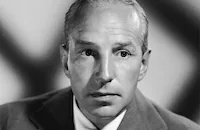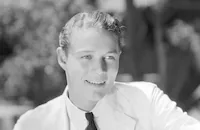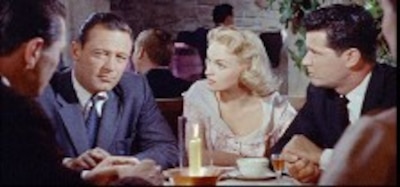Toward the Unknown

Brief Synopsis
Cast & Crew
Mervyn Leroy
William Holden
Lloyd Nolan
Virginia Leith
Charles Mcgraw
Murray Hamilton
Film Details
Technical Specs

Synopsis
Maj. Lincoln Bond, an ace pilot who was captured and tortured during the Korean War, returns to the Flight Test Center at Edwards Air Force Base, hoping to be rehired as a test flier. Col. R. H. "Mickey" McKee, Lincoln's close friend who is second in command there, is willing to hire him, but needs permission from his superior, Brig. Gen. Bill Banner. Bill is sympathetic, but rejects Lincoln's request, believing that his breakdown under torture, during which he signed a paper admitting to germ warfare, suggests he is too unstable to resume flying. Lincoln is also disappointed that his girl friend, Bill's secretary Connie Mitchell, is romantically involved with Bill, having given up on Lincoln when he refused to communicate with her during his recovery. A few days later, Lincoln asks Bill to reconsider and, when refused, asks for any job on the base, explaining that he needs to be near the air field. Bill, who understands Lincoln's devotion to flying, hires him to assist with testing on a strictly limited basis. On another day, Bill gives Lt. Gen. Bryan Shelby and Senator Black a tour of the base, and shows them the latest development in aircraft, the X-2. Possessing two rocket-powered engines, the plane is expected to fly faster than the speed of sound. Shelby tries to convince Bill to accept a promotion to the Air Force's research and development department in Washington, but Bill refuses the office job. Vigorous despite his advancing age, Bill still flies the most dangerous test flights. His attitude concerns Shelby, Mickey and the other pilots, who presume that a pilot will need split-second reflexes to survive flying faster than anyone has ever flown. Lincoln, while flying a test plane, experiences problems and expertly lands under dangerous conditions, where, on the ground, the airmen discover that the plane's wings have wrinkled. Although Lincoln believes that there is a structural problem, the engineers and another test pilot think that Lincoln tried to exceed the limits of the plane's design. News of the problem reaches H. G. Gilbert, the owner of the company that built the plane and he, too, insists that the plane has no structural problems. Despite the protests of most of his team, Bill orders another test flight before committing the plane to mass production. Flying together in separate planes, Lincoln and Bill try to recreate the problem conditions, but both planes operate smoothly. After the flight, Bill nearly passes out in the locker room, but claims that he only tripped. Over time, Lincoln gains Bill's respect and is trusted with difficult test flights. On another flight, Lincoln and Bill are again flying in separate planes when Bill's drag chute breaks loose. To prevent the chute from opening, which will cause Bill's plane to spin, Lincoln flies his plane at close range directly behind Bill, so that the chute drapes on the nose of Lincoln's plane. In this dangerously close formation, the two planes land and afterward, Bill acknowledges that Lincoln saved his life. Candidly, Bill admits that he cannot understand the discrepancy between Lincoln's calmness under stress and the story of him breaking under torture. Knowing that he cannot explain the experience of psychological torture to someone who has not lived it, Lincoln says that solitary confinement is harder than physical torture. At a party celebrating the promotion of Lincoln's friend, Maj. Joe Craven, recovering alcoholic Maj. Bromo Lee, who is considered the best pilot on base, gets drunk and picks a fight with Lincoln. Although he tries to ignore Bromo's insults, Lincoln loses control when Bromo's drunken buddy pins him down while Bromo hits him. Lincoln fights back hard, knocking Bromo unconscious. Then, depressed that he has proven himself to be unstable, Lincoln retreats to the hangar where the X-2 is parked. There he encounters Hank, the X-2's engineer, who talks about the aircraft's role in future space travel and how he, like most pilots, covets the opportunity to be the first to fly it at full speed. The next day, Bill reprimands Bromo for his drinking lapse and, when Lincoln offers to resign, attributes his behavior to self-defense. When Mickey reports that Joe is experiencing wing problems mid-flight on the X-2, Bill radios Joe to bail out. However, Joe delays until after the wings fracture and, once he finally ejects, his parachute opens too late to save him. Lincoln is sent to give the bad news to Joe's widow Polly and is later promoted to Joe's position as head of the X-2 project. Later, despite revisions and setbacks, the team is almost ready to test the X-2 with full rocket power, but no one knows how a man will withstand flying faster than the speed of sound. Ordered by Shelby to take the promotion, Bill delays accepting the post until he personally performs the final test. Although Bill feels responsible for making the dangerous flight, his colleagues believe he is wrongfully risking his life. Connie, who is sorting out her feelings for both men, is also worried and expresses her concern to Lincoln. When Lincoln reminds Bill of the time he nearly passed out in the locker room and suggests that he is jeopardizing the project with "blind egotism and stubborn pride," Bill, admitting that he must soon relinquish control, stands firm about flying the final test. On the day of the flight, Hank asks to redo a previous test before proceeding with the use of both rockets, so Bill assigns Lincoln to the penultimate test flight. The mother plane, a B-50, takes off, and from inside, the X-2 is "dropped" or shot out. Lincoln, who is piloting the X-2, decides to disobey orders and engages both engines, risking his life in place of Bill's. Soon, the plane spins and its controls fail to respond. The experimental faceplate serving as Lincoln's mask also malfunctions. After Lincoln ejects, without benefit of a mask, his chute opens in time. Mickey later reports to Bill that Lincoln was unconscious for some of the ordeal, and that he suffers from a concussion, an injured hip, and a severe case of the bends. The doctor concludes that Lincoln survived because of his excellent physical condition and warns that Bill, at his age, would have perished. Concerned about discipline, Shelby notes that Lincoln violated written orders, but Bill saves Lincoln from a reprimand by saying that he had verbally ordered him to make the final test. When Bill later boards a plane for Washington, leaving Mickey as his replacement, both Mickey and Lincoln, who has sneaked out of the hospital, see him off. Connie decides to stay with Lincoln, and although disappointed, Bill says that Lincoln deserves her.

Director

Mervyn Leroy
Cast

William Holden

Lloyd Nolan

Virginia Leith

Charles Mcgraw

Murray Hamilton

Paul Fix

James Garner
L. Q. Jones

Karen Steele
Bartlett Robinson
Malcolm Atterbury
Ralph Moody
Maura Murphy
Carol Kelly
Don Harvey

Jean Willes

William Henry
Jon Provost
Crew
Al Alleborn
Paul Baron
Gordon Bau
John Beckman
Robert Crawford
Mel Dollar
Lt. Col. Frank Everest Jr. Ardc
Maj. Price Henry Ardc
Ralph Hurst
Stanley Jones
H. F. Koenekamp
Leo K. Kuter
Beirne Lay Jr.
Beirne Lay Jr.
Mervyn Leroy
Russell Llewellyn
Moss Mabry
Lt. Col. Ralph Martin Ardc
Thomas Reilly
Hal Rosson
Russ Saunders
Harold E. Wellman
William Ziegler

Film Details
Technical Specs

Articles
Toward the Unknown
By Frank Miller

Toward the Unknown
Quotes
Trivia
Notes
An acknowledgment after the opening credits reads: "Our sincere thanks to the United States Air Force for their help in the making of this motion picture. Airmen yet unborn will some day also add their thanks to today's pioneers of the skies." Beirne Lay, Jr.'s onscreen credit reads: "Written by Beirne Lay, Jr., Associate Producer."
Toward the Unknown was announced in an April 1954 Daily Variety news item as a Columbia production on producer Robert Cohn's schedule. However, an October 1955 Daily Variety news item reported that Jack L. Warner had closed a deal for the property and that it marked the first film for William Holden's company, Toluca Productions. As noted in Hollywood Reporter production charts and a March 1956 Hollywood Reporter news item, much of the film was shot at Edwards Air Force Base, in Southern California.
According to the Motion Picture Herald Prod Digest review and a sign shown in the film, the title of the film, Toward the Unknown, is the verbatim motto of the real-life Flight Test Center at Edwards Air Force Base. The Time and New York Times reviews mentioned that, during the three months before the film was released, the Air Force's Bell X-2 experimental rocket plane, which is featured in the film, had set a speed record for manned aircraft of 1,900 miles per hour and an altitude record of 126,000 ft. above sea level, before crashing in the desert.
Although their appearance in the film has not been confirmed, contemporary Hollywood Reporter news items add the following actors to the cast: Carol Kelly, Eleanore Moore, Don Blackman, Bob Stratton, John Day, Red Fulton and four-year-old Cathy Ferrara. Modern sources add John Daheim, Robert Hover, Les Johnson, Nelson Leigh, Autumn Russell, Will White, and Major James Wilson to the cast.
Although a February 1956 Hollywood Reporter news item stated that James Garner made his feature film debut in Toward the Unknown, Garner earlier appeared in the 1950 RKO production Joan of Arc as a tumbler. He also appeared in Warner Bros.' The Girl He Left Behind, which was released approximately one week before, but shot one month after, Toward the Unknown.

Miscellaneous Notes
Released in United States Fall October 1956
Released in United States Fall October 1956














